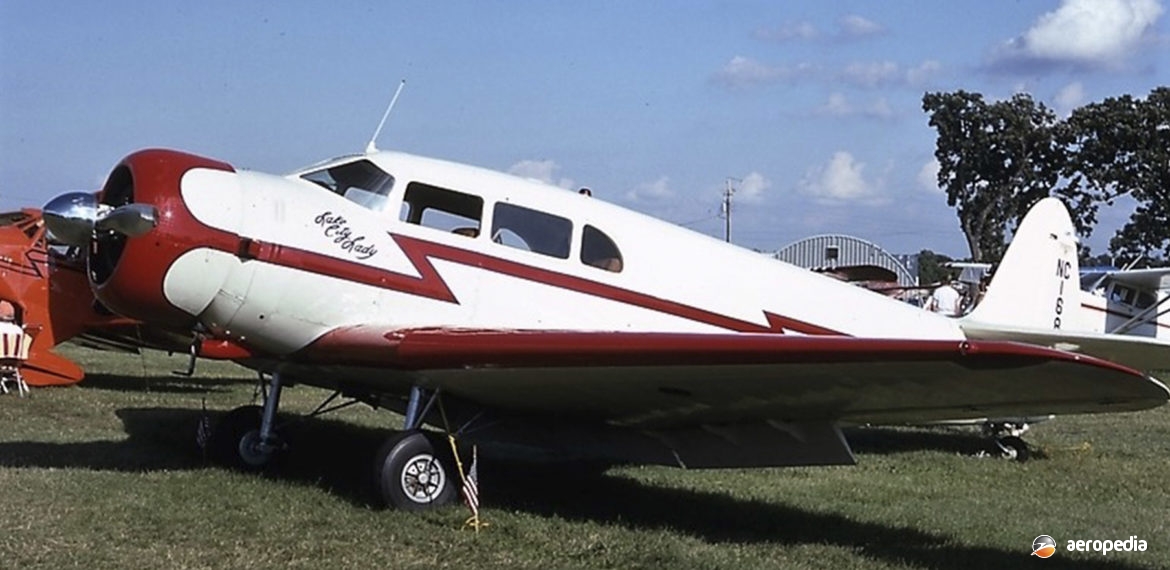Photograph:
A Fairchild F45A NC16876 (c/n 4012) visiting the Experimental Aircraft Association (EAA) event at Oshkosh, Wisconsin USA in 1991 (Author’s collection)
Country of origin:
United States of America
Description:
Business and executive monoplane
Power Plant:
One 261 kw (350 hp) Wright R-760-E2 seven-cylinder air-cooled radial engine
Specifications:
- Wingspan: 12.03 m (39 ft 6 in)
- Length: 9.17 m (30 ft 1 in)
- Height: 2.49 m (8 ft 2 in )
- Wing area: 23.03 m² (248 sq ft)
- Max speed at sea level: 274 km/h (170 mph)
- Cruising speed at 1,900 rpm at sea level: 241 km/h (150 mph)
- Cruising speed at 2,438 m (8,000 ft): 264 km/h (164 mph)
- Landing speed with flaps: 87 km/h (54 mph)
- Stalling speed with no flaps: 100 km/h (62 mph)
- Rate of climb at sea level: 305 m/min (1,000 ft/min)
- Service ceiling: 5,700 m (18,700 ft)
- Standard fuel capacity: 341 litres (75 Imp gals)
- Optional fuel capacity 454 litres (100 Imp gals): 568 litres (125 Imp gals)
- Cruising range at 1,950 rpm with standard fuel: 1,046 km (650 miles)
- Cruising range with 568 litres (125 Imp gals): 1,851 km (1,150 miles)
- Empty weight: 1,139 kg (2,512 lb)
- Useful load: 675 kg (1,488 lb)
- Payload weight with 340 litres ( 75 Imp gals) of fuel, 4 passengers and 24 kg (53 lb)b
- aggage: 332 kg (733 lb)
- Loaded weight: 1,814 kg (4,000 lb)
History:
The Model 45 produced by the Fairchild Corporation was known, when first introduced, as ‘The Sedan of the Air’ and was aimed at meeting a market for a high-speed transport with good capacity, comfort and convenience normally associated with an expensive automobile. It had a roomy cabin with entrance through two doors, a luxurious interior and an above-average performance. It was designed by a team headed by George W Hardman, the Company’s chief engineer, and the prototype first flew on 31 May 1935 in the hands of Richard Henson, Fairchild’s chief test pilot, Certification ATC-588 being received on 3 December 1935. First test flight was 3 hrs 20 mins.
The first production aircraft was delivered to the Superior Oil Company of Houston, Texas. The prototype NC15060 (c/n 4000) ended up being the only example fitted with the Jacobs L-4 engine. Buyers required more power and some re-design was carried out. Production aircraft were fitted with the 261 kw (350 hp at 2,400 rpm) Wright R-760-E2 radial engine driving a Hamilton-Standard metal fixed-pitch propeller, and a controllable-pitch propeller was an option.
Most aircraft sold on the civil market were to sportsman-pilots and mining and oil companies. Two were built for the Argentine Navy (c/ns 4007 and 4008) and the United States Navy received one in 1943 as the JK-1 (c/n 4006) for use as a VIP transport. Production concluded in March 1939 after 17 examples of the F45 and F45A had been delivered.
The F45A was a cantilever low-wing monoplane with seating for five and received Type Certificate ATC-603 on 29 April 1936, 16 examples of the F45A being delivered from the Company’s facility at Hagerstown, Maryland. One example was sold in South Africa, becoming ZS-AML (c/n 4002 – ex NC16361) but was scrapped in October 1951. During World War II two were impressed into the United States Army Air Force (USAAF) as light transports and became known as the UC-88 (c/ns 4004 and 4013). Three were sold to the Honduran Air Force (c/ns 4001, 4005 and 4010).
Well known American pilot Budd Davisson (Editor-in- Chief of ‘Flight Journal’) in 1991 described the F45 as “aimed at the growing mid-Depression executive transport market and addressed that market in exactly the same manner as the Spartan Executive and the Beech 17 Staggerwing but, like the former, was only produced in small numbers”. He further stated the Model 45 “was…also designed to give them something else – incredibly easy and forgiving flight characteristics that would make it much easier for a businessman / owner to be his own chauffeur while the other two airplanes tended toward having professional pilots on board”. He later went on to say “the Fairchild 45 is a totally unique piece of aeronautical history that offers a wonderfully nostalgic glimpse into a time where comfort and appointments were more important than cost and speed”.
After World War II the survivors only lasted for a few years before becoming derelict across American airports and by the mid 1990s only a few survived. In later years two have continued to fly in America, one fitted with a Pratt & Whitney engine providing 336 kw (450 hp) and the other a 313 kw (420 hp) Wright unit.
In October 2016 an F45A project arrived in New Zealand at Omaka for an enthusiast for restoration to airworthiness. This aircraft was built in June 1937 as NC16876 (c/n 4012) and had a number of operators. Fitted with a Wright R-760 engine it was based in Portland, Oregon in 1953 at which time it was fitted with a Lycoming R-680 radial engine. This was replaced two years later with a Pratt & Whitney R-985-17 engine. The main owner after that was Arwood Flying Services from 1961 to 1977 when the fabric covering was replaced with metal in mid 1963. From 1977 it was based in Missouri before being placed in storage and falling into a derelict condition.
Other examples registered in the United States have included NC16877 (c/n 4013), NC16878 (c/n 4014), NC16864 (c/n 4010) and NC16865 (c/n 4011).

